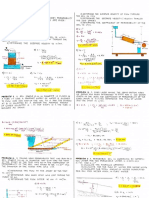0 ratings0% found this document useful (0 votes)
55 viewsGeotech Compress. of Soils
Geotech Compress. of Soils
Uploaded by
John Fred Marzan CativoCopyright:
© All Rights Reserved
Available Formats
Download as PDF or read online from Scribd
Geotech Compress. of Soils
Geotech Compress. of Soils
Uploaded by
John Fred Marzan Cativo0 ratings0% found this document useful (0 votes)
55 views8 pagesCopyright
© © All Rights Reserved
Available Formats
PDF or read online from Scribd
Share this document
Did you find this document useful?
Is this content inappropriate?
Copyright:
© All Rights Reserved
Available Formats
Download as PDF or read online from Scribd
Download as pdf
0 ratings0% found this document useful (0 votes)
55 views8 pagesGeotech Compress. of Soils
Geotech Compress. of Soils
Uploaded by
John Fred Marzan CativoCopyright:
© All Rights Reserved
Available Formats
Download as PDF or read online from Scribd
Download as pdf
You are on page 1of 8
5 primay
"Y Consolidation
Co= com
PIeSsion inday
009 (LL - 49)
€0= in sity Void ratio
St= So+ 85+ Se H= thickness of clay layer
AP= average incre;
Settlement
a8€ Of effective
stress on Clay layer
leon nena
Sc= primary consolidation
settlement
Ss= secondary Consolidation Llays
settlement
immediate or elastic settlement
Over consolidat
those whose
Overburden pres
which the soil
past.
led clays are
Present. effective
Sure is less than that
experienced in the
® when Py +ap< Po
Po = preconsolidation pressure
CoH (Py + AP
Normally Consolidated clays are Sc* 746, log (5)
those Whose present effective a
Overby
Uurden pressure is the maximum
essure that the soil was subjected Cg = swell index a
0 in the Past. The maximum tos} of Cy)
Sfective past Pressure is called the (ranges from 5 to 19 of Ce
Preconsolig
lation pressure.
hen Po +AP> Pe
° Ps = preconsolidation pressure
CoH Po + AP
Te, ns ) H Po + AP.
tte P, Begs )
; ° CsH 84S log fer-yeny
Sc*74 5 9P, "1+ e% e
~
the clay layer caused by primary consolidation
it
a) The clay is normally consolidated.
b) The preconsolidation pressure
(Pc) = 190 kPa
c) _ The preconsolidation pressure
Po = 170 kPa.
For a given over consolidated clay:
Sp.gr.=2.71
Liquid limit = 45 |
In situ average effective over burden
= 120 kPa.
In situ void ratio = 0.80
Thickness of clay layer = 4 m.
AP = 40 kPa.
Effective pressure at the mid-height of Clay
layer = 60 kPa.
Pressure
Swell index (C3) = 5 Ce
a) Compute the compression index.
b) Compute the pre consolidation pressure
c) Compute the primary consolidation
settlement.
From the figure shown, the water table is
located 2 m. below the ground surface. A
uniform load AP = 120 kPa is acting at the tp
of the water surface.
AP=120 kPa
a
pROBLEMS for. EXERCISI
) Compute the saturated unit weight of
4)
sand
put the overburden pressure atthe
mrid-height of clay.
Compute the primary consolidation
settlement.
Giuen the following data for @ normally
consolidated clay layer in the field,
Thickness of clay layer = 2.6 m.
1.30
Primary compression index Cg =
‘oid ratio = 0.80
Ave. efectve pressure at the mid height of the
clay layer Po = 127 kPa
AP=45 Pa (increase in vertical pressure)
Seeonday compression index Coy = 0.02
Compute the primary consolidation
settlement.
Compute the secondary settlement of the
lay layer five years after the completion
of primary settlement. Time for
Completion of primary settlement is 1.5
Ys.
Compute the total consolidation
Settlement.
389
ue
For a laboratory consolidation test on a clay
‘specimen (drained on both sides) the following
results were obtained,
Thickness of the clay soil = 25 mm
Py =50 kPa
P2= 120 kPa
Time for 50% consolidation = 2.5 min.
Ty=0.197
a) Determine the coeff. of compressibility
b) Determine the coeff. of consolidation.
c) Determine the hydraulic conductivity of
the clay for the loading range
The square footing having a dimension of
3mx 31m. is resting on a soil having the given
properties as shown on the figure. It carries a
concentrated load of 1800 KN. The undrained
elastic modulus of clay is estimated to be
40 MPa with a Poissons ratio of 0.5.
i KN
24m) el7 Nin? *
LL=41%
e,-0.80
Ti eae eel
Rock
390
PROBLEMS for EXERCISES _
a) Compute the expected immediate
settlement beneath the center of the
footing. If the footing has a shape and
foundation rigidity factor Cz = 0.82
b) Compute the settlement due to primary
consolidation of clay if the clay has a void
ratio of 0.80 and a liquid limit of 47%.
Use the weighted average method of
computing the average increase in
pressure.
c) Compute the total settlement expected
over a 20 year time span assuming full
primary consolidation of the clay requires
approximately 5 years. Compression
index for secondary compression is
equal to 0.0136.
The coordinates of two points on a given
compression curve are as follows
4 = 1.82 P,=200 KPa
eg 1.54 P= 400 kPa
Compute the coefficient of
compressibility
b) Compute the coefficient of volume
compressibility for the pressure range
Stated above.
©) Given the coefficient of consolidation
Cy = 0.003 cm/sec., determine the
hydraulic conductivity (K) in cm/sec
corresponding to the average void ratio,
A square footing having a dime
3m. x3 m. carries an axial load of eon fi
The bottom of the footing is 2 mg, 10 ky
ground surface consisting of a jayes(0 be
overlying a 4 m. layer of clay. The ya” até
is located 2 m. below the ground ar tae
Dry unit weight of sand = 16.5 kNim3
Saturated unit weight of clay is = 20 kind
Void ratio of clay = 0.80
Liquid limit of clay = 50%
a) Compute the increase in the vera
pressure. 7
b) Compute the overburden pressure 4
midpoint of clay. io
sai
c) Compute the primary consol
settlement.
>
poBLEMs for EXERCISES
pl
iyen soil profile shown, the ground
“pected to a uniform increase in
et esse SP = 10, Tim?, Dry Unit
veal sand is 1.77 Tim and a saturated
weit ri of 205 Tim®, The 10m. layer of
utter a 3m. layer of clay which has a
3 te, a water content of 42% with
sane
we 76. Ground water table is located
a
an. below the ground surface.
suf
AP=10 Tim?
Compute the effective unit weight of clay.
Compute the overburden pressure at the
mid point of the clay.
Compute the primary consolidation
setlement.
A 10 ft x 10 ft. footing carries a total load of
280 tons is shown on the figure. Standard
Penetration tests were conducted on the site.
Test results were corrected for over burden
pressure and the corrected N-values are listed
as shown.
Depth (ft) Corrected N-values
5.0 a
75 36
10.0 30
125 2B
15.0 35
75 33
20.0 31
f° tons
es 10° 10" .
a) Compute the lowest average corrected
Nevalue for design,
b) Compute the max. expected settlement
for this footing in inches.
©) Compute the max. expected settlement
for this footing if the ground water table is
located 7 ft. below the ground level. Dry
unit weight is 124 pof., assume saturated
unit weight of sand is 124 pe.
The construction of a 24 m. diamet
a weight of 86.4 kPa is proposed on site where
the soil profile consists of a 6 m. layer 0
saturated stiff clay supported on bedrock and
overlain by a 9 m. layer of medium-dense
sand. The ground water level is 3 m. below
the ground surface. The sand has a unit
weight of 17.6 kNim® and a saturated unit
weight 20.4 kNim3. The stiff clay is normally
consolidated and has the following
characteristics. Saturated unit weight of 18.10
kNim3, Water content of 44%, unconfined
compressive strength of 136 kPa. Specific
gravity of 2.78, plasticity index of 25% and a
plastic limit of 20%. Calculated vertical stress
increase at the center of the clay layer 12m.
below the ground surface is 56 kPa.
fer tank with
a) Compute the compressive index Cy,
b) Compute the preconsolidation pressure
at center of clay layer.
c) Compute the settlement under the center
of ite ay due to consolidation of the 6
m, layer of clay resulting from thi
of the tank. % 2
wea
‘Asquare footing 8 ft. x 8 ft located 5 f bey
ground level is to be constructed on gq,
Standard penetration tests were conducteg
the site. Test results were correcteg A
overburden pressures, and the lowest avera or
corrected N-value was determined to be 44
a) Determine the allowable soil pressure for
a maximum settlement of 1 in if ground
water was not encountered.
b) Ifthe ground water table is located 6 ft.
below the ground level and the unit
weight of sand is 128 Ibyft? and saturated
unit weight is 128 Ib/ft®, compute the
correction to be applied to the settlement
when the ground water table is located
a depth below the base of the footing
less than half the footing's width where
the correction is equal to the ratio of
effective overburden pressure at depth
B/2 below the footing's base, assuming
thatthe ground water table isnot pres”
to the effective overburden pressu’e al
the same depth with the ground W@ lef
table present.
©) Determine the allowable sol pressu®
a maximum setiement of # in. it
ground water table is 6 ft, below '""
ievel and the sands unit weight "2°
If both cry and saturated unit weal
_
_@e
coM
eat 393
pRESSIBILITY OF SOIL
a
a [58.17mm. | a 1.081 x 103 m2/kN a
b154mm. |b | 123x105 m/min b
¢ | 73.57mm. | | 131x107 m/min, | € |
a0 =
' 3
a 1.4x 103 m2/k
72.88 kPa
Sie
> Rk
- g
q
0.82 T/m3
b 5.224 x 10° m2/kN
© | 1.537 x 107 cm/sec.
53.38 IPs
14.61 T/m2).
b
0.315 |
141.21 kPa,
5.44 tons/ft2
You might also like
- The Subtle Art of Not Giving a F*ck: A Counterintuitive Approach to Living a Good LifeFrom EverandThe Subtle Art of Not Giving a F*ck: A Counterintuitive Approach to Living a Good LifeRating: 4 out of 5 stars4/5 (5991)
- The Gifts of Imperfection: Let Go of Who You Think You're Supposed to Be and Embrace Who You AreFrom EverandThe Gifts of Imperfection: Let Go of Who You Think You're Supposed to Be and Embrace Who You AreRating: 4 out of 5 stars4/5 (1112)
- Never Split the Difference: Negotiating As If Your Life Depended On ItFrom EverandNever Split the Difference: Negotiating As If Your Life Depended On ItRating: 4.5 out of 5 stars4.5/5 (899)
- Hidden Figures: The American Dream and the Untold Story of the Black Women Mathematicians Who Helped Win the Space RaceFrom EverandHidden Figures: The American Dream and the Untold Story of the Black Women Mathematicians Who Helped Win the Space RaceRating: 4 out of 5 stars4/5 (932)
- Grit: The Power of Passion and PerseveranceFrom EverandGrit: The Power of Passion and PerseveranceRating: 4 out of 5 stars4/5 (619)
- Shoe Dog: A Memoir by the Creator of NikeFrom EverandShoe Dog: A Memoir by the Creator of NikeRating: 4.5 out of 5 stars4.5/5 (546)
- The Hard Thing About Hard Things: Building a Business When There Are No Easy AnswersFrom EverandThe Hard Thing About Hard Things: Building a Business When There Are No Easy AnswersRating: 4.5 out of 5 stars4.5/5 (357)
- Her Body and Other Parties: StoriesFrom EverandHer Body and Other Parties: StoriesRating: 4 out of 5 stars4/5 (831)
- Elon Musk: Tesla, SpaceX, and the Quest for a Fantastic FutureFrom EverandElon Musk: Tesla, SpaceX, and the Quest for a Fantastic FutureRating: 4.5 out of 5 stars4.5/5 (477)
- The Emperor of All Maladies: A Biography of CancerFrom EverandThe Emperor of All Maladies: A Biography of CancerRating: 4.5 out of 5 stars4.5/5 (275)
- The Little Book of Hygge: Danish Secrets to Happy LivingFrom EverandThe Little Book of Hygge: Danish Secrets to Happy LivingRating: 3.5 out of 5 stars3.5/5 (426)
- The World Is Flat 3.0: A Brief History of the Twenty-first CenturyFrom EverandThe World Is Flat 3.0: A Brief History of the Twenty-first CenturyRating: 3.5 out of 5 stars3.5/5 (2281)
- The Yellow House: A Memoir (2019 National Book Award Winner)From EverandThe Yellow House: A Memoir (2019 National Book Award Winner)Rating: 4 out of 5 stars4/5 (99)
- The Sympathizer: A Novel (Pulitzer Prize for Fiction)From EverandThe Sympathizer: A Novel (Pulitzer Prize for Fiction)Rating: 4.5 out of 5 stars4.5/5 (125)
- Devil in the Grove: Thurgood Marshall, the Groveland Boys, and the Dawn of a New AmericaFrom EverandDevil in the Grove: Thurgood Marshall, the Groveland Boys, and the Dawn of a New AmericaRating: 4.5 out of 5 stars4.5/5 (270)
- A Heartbreaking Work Of Staggering Genius: A Memoir Based on a True StoryFrom EverandA Heartbreaking Work Of Staggering Genius: A Memoir Based on a True StoryRating: 3.5 out of 5 stars3.5/5 (232)
- Team of Rivals: The Political Genius of Abraham LincolnFrom EverandTeam of Rivals: The Political Genius of Abraham LincolnRating: 4.5 out of 5 stars4.5/5 (235)
- On Fire: The (Burning) Case for a Green New DealFrom EverandOn Fire: The (Burning) Case for a Green New DealRating: 4 out of 5 stars4/5 (75)
- The Unwinding: An Inner History of the New AmericaFrom EverandThe Unwinding: An Inner History of the New AmericaRating: 4 out of 5 stars4/5 (45)
- CMT - Module 7 (STEEL)Document7 pagesCMT - Module 7 (STEEL)John Fred Marzan CativoNo ratings yet
- Properties of SoilDocument6 pagesProperties of SoilJohn Fred Marzan CativoNo ratings yet
- Stresses in SoilDocument6 pagesStresses in SoilJohn Fred Marzan CativoNo ratings yet
- Flow of Water in SoilDocument7 pagesFlow of Water in SoilJohn Fred Marzan CativoNo ratings yet
- Fluid MechanicsDocument3 pagesFluid MechanicsJohn Fred Marzan CativoNo ratings yet













































